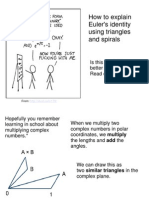Javascript Class4 Notes and Task
Uploaded by
Soumya RoyJavascript Class4 Notes and Task
Uploaded by
Soumya RoyCreate a web-page that asks for a name and outputs it.
<html>
<body>
<script>
let name = prompt("What is your name?", "");
alert(name);
</script>
</body>
</html>
Type Conversions
Most of the time, operators and functions automatically convert the values given to
them to the right type.
For example, alert automatically converts any value to a string to show it.
Mathematical operations convert values to numbers.
String Conversion
String conversion happens when we need the string form of a value.
For example, alert(value) does it to show the value.
We can also call the String(value) function to convert a value to a string:
let value = true;
alert(typeof value); // boolean
value = String(value); // now value is a string "true"
alert(typeof value); // string
Numeric Conversion
Numeric conversion in mathematical functions and expressions happens automatically.
For example, when division / is applied to non-numbers:
alert( "6" / "2" ); // 3, strings are converted to numbers
We can use the Number(value) function to explicitly convert a value to a number:
let str = "123";
alert(typeof str); // string
let num = Number(str); // becomes a number 123
alert(typeof num); // number
Basic operators, maths
The following math operations are supported:
Addition +,
Subtraction -,
Multiplication *,
Division /,
Remainder %,
Exponentiation **.
Remainder % The remainder operator %, despite its appearance, is not related to percents.
The result of a % b is the remainder of the integer division of a by b.
For instance:
alert( 5 % 2 ); // 1, the remainder of 5 divided by 2
alert( 8 % 3 ); // 2, the remainder of 8 divided by 3
Exponentiation ** The exponentiation operator a ** b raises a to the power of b.
In school maths, we write that as ab.
For instance:
alert( 2 ** 2 ); // 2² = 4
alert( 2 ** 3 ); // 2³ = 8
A code that asks the user for two numbers and shows their sum.
<html>
<head></head>
<body>
<script>
let x=prompt('Enter a number:','1');
let y=prompt('Enter another number:','2');
let z=Number(x)+Number(y);
alert(`Your value ${z}`);
</script>
</body>
</html>
String concatenation with binary +
If the binary + is applied to strings, it merges (concatenates) them:
let s = "my" + "string";
alert(s); // mystring
Note that if any of the operands is a string, then the other one is converted to a string too.
For example:
alert( '1' + 2 ); // "12"
alert( 2 + '1' ); // "21"
It doesn’t matter whether the first operand is a string or the second one.
Example:
alert(2 + 2 + '1' ); // "41" and not "221"
The binary + is the only operator that supports strings in such a way. Other arithmetic operators work
only with numbers and always convert their operands to numbers.
Here’s the subtraction and division:
alert( 6 - '2' ); // 4, converts '2' to a number
alert( '6' / '2' ); // 3, converts both operands to numbers
Task:
What are the final values of all variables a, b, c and d after the code below?
let a = 1, b = 1;
let c = ++a; // ?
let d = b++; // ?
What are the values of a and x after the code below?
let a = 2;
let x = 1 + (a *= 2);
What are results of these expressions?
1. "" + 1 + 0
2. "" - 1 + 0
3. true + false
4. 6 / "3"
5. "2" * "3"
6. 4 + 5 + "px"
7. "$" + 4 + 5
8. "4" - 2
9. "4px" - 2
10. " -9 " + 5
11. " -9 " - 5
12. null + 1
13. undefined + 1
14. " \t \n" - 2
You might also like
- Learn JavaScript - Introduction Cheatsheet - CodecademyNo ratings yetLearn JavaScript - Introduction Cheatsheet - Codecademy5 pages
- JavaScript Fundamentals - Intro To JavaScript For APIs Cheatsheet - CodecademyNo ratings yetJavaScript Fundamentals - Intro To JavaScript For APIs Cheatsheet - Codecademy5 pages
- Computer Engineering Department: TH e o R YNo ratings yetComputer Engineering Department: TH e o R Y4 pages
- Learn JavaScript - Introduction Cheatsheet - CodecademyNo ratings yetLearn JavaScript - Introduction Cheatsheet - Codecademy5 pages
- Handson Lab JavaScript Browser Console EdxNo ratings yetHandson Lab JavaScript Browser Console Edx8 pages
- Lecture 2 - Operators & Conditional StatementsNo ratings yetLecture 2 - Operators & Conditional Statements9 pages
- Console - Log : / Learn Javascript CheatsheetsNo ratings yetConsole - Log : / Learn Javascript Cheatsheets6 pages
- Numerical Constant - May Be An Integer or Real Number. CharacteristicsNo ratings yetNumerical Constant - May Be An Integer or Real Number. Characteristics13 pages
- Learn JavaScript - Introduction Cheatsheet - CodecademyNo ratings yetLearn JavaScript - Introduction Cheatsheet - Codecademy7 pages
- Advancements in Blockchain Technology For Healthcare Data SecurityNo ratings yetAdvancements in Blockchain Technology For Healthcare Data Security7 pages
- Sambalpur University Institute of Information Technology (Suiit) Advertisement For The Post of JRF in An SERB Sponsored ProjectNo ratings yetSambalpur University Institute of Information Technology (Suiit) Advertisement For The Post of JRF in An SERB Sponsored Project3 pages
- Rational Points On Elliptic Curves Silverman Tate PDFNo ratings yetRational Points On Elliptic Curves Silverman Tate PDF11 pages
- 2024 Mathematics Olympiad Past Paper Central Province Category III English MediumNo ratings yet2024 Mathematics Olympiad Past Paper Central Province Category III English Medium5 pages
- Statement and Conclusions - Logical Reasoning questionsNo ratings yetStatement and Conclusions - Logical Reasoning questions9 pages
- The Fundamental Theorem Difference Equations Differential Equations of CalculusNo ratings yetThe Fundamental Theorem Difference Equations Differential Equations of Calculus12 pages
- Exponential and Logarithms (To Replace Sections 7.2-7.5) : Alfonso Gracia-Saz, MAT 137No ratings yetExponential and Logarithms (To Replace Sections 7.2-7.5) : Alfonso Gracia-Saz, MAT 1376 pages
- Clear SSC CGL REASONING in 1 Day Predicted Question Bank in PDF With SolutionsNo ratings yetClear SSC CGL REASONING in 1 Day Predicted Question Bank in PDF With Solutions19 pages
- Homework Solving Exponential and Logarithmic Equations100% (1)Homework Solving Exponential and Logarithmic Equations5 pages
- How To Explain Euler's Identity Using Triangles and Spirals50% (2)How To Explain Euler's Identity Using Triangles and Spirals25 pages
- Additional Mathematics - I: Visvesvaraya Technological University, BelagaviNo ratings yetAdditional Mathematics - I: Visvesvaraya Technological University, Belagavi4 pages

































































































